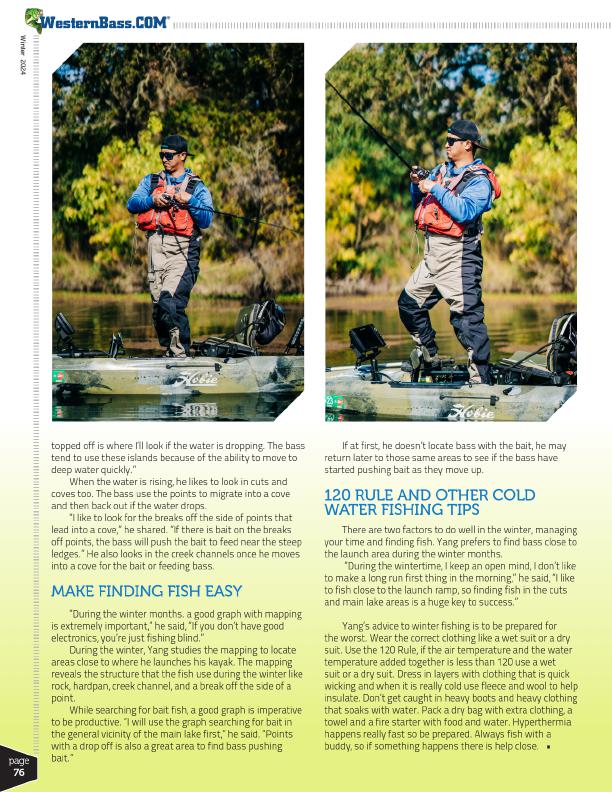
®
Winter 2024
page
76
topped off is where I’ll look if the water is dropping. The bass tend to use these islands because of the ability to move to deep water quickly.”
When the water is rising, he likes to look in cuts and coves too. The bass use the points to migrate into a cove and then back out if the water drops.
“I like to look for the breaks off the side of points that lead into a cove,” he shared. “If there is bait on the breaks off points, the bass will push the bait to feed near the steep ledges.” He also looks in the creek channels once he moves into a cove for the bait or feeding bass.
MAKE FINDING FISH EASY
“During the winter months. a good graph with mapping is extremely important,” he said, “If you don’t have good electronics, you’re just fishing blind.”
During the winter, Yang studies the mapping to locate areas close to where he launches his kayak. The mapping reveals the structure that the fish use during the winter like rock, hardpan, creek channel, and a break off the side of a point.
While searching for bait fish, a good graph is imperative to be productive. “I will use the graph searching for bait in the general vicinity of the main lake first,” he said. “Points with a drop off is also a great area to find bass pushing bait.”
If at first, he doesn’t locate bass with the bait, he may return later to those same areas to see if the bass have started pushing bait as they move up.
120 RULE AND OTHER COLD WATER FISHING TIPS
There are two factors to do well in the winter, managing your time and finding fish. Yang prefers to find bass close to the launch area during the winter months.
“During the wintertime, I keep an open mind, I don’t like to make a long run first thing in the morning,” he said, “I like to fish close to the launch ramp, so finding fish in the cuts and main lake areas is a huge key to success.”
Yang’s advice to winter fishing is to be prepared for the worst. Wear the correct clothing like a wet suit or a dry suit. Use the 120 Rule, if the air temperature and the water temperature added together is less than 120 use a wet suit or a dry suit. Dress in layers with clothing that is quick wicking and when it is really cold use fleece and wool to help insulate. Don’t get caught in heavy boots and heavy clothing that soaks with water. Pack a dry bag with extra clothing, a towel and a fire starter with food and water. Hyperthermia happens really fast so be prepared. Always fish with a buddy, so if something happens there is help close. •